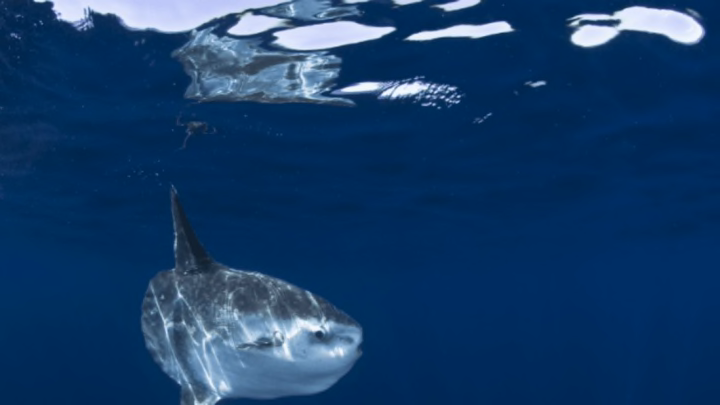The Mola mola—which looks like a prehistoric shark that lost a tail in an epic battle—might be the world's weirdest fish. Here are just a few reasons it's the most fascinating marine creature around.
1. They love to sunbathe.
Sunfish spend up to half the day basking in the sun near the surface of the water, which helps warm their bodies up after deep water dives to hunt.
2. They can weigh more than a car.
The average ocean sunfish is 10 feet long and weighs 2200 pounds, but the biggest can grow up to 5000 pounds. The average pickup truck is only 4000. This makes them the world's largest bony fish.
3. They lay more eggs than any other animal.
Image Credit: Pline via Wikimedia Commons // Public Domain
Sunfish can lay up to 300,000,000 eggs at one time, more than any other vertebrate.
4. They have super weird teeth.
Mola mola teeth are fused together in two plates that look like a parrot’s beak.
5. They are related to the bass.
Largemouth bass, smallmouth bass, rock bass, and black bass are all members of the sunfish family. Bass generally eat the smaller members of the sunfish family, like bluegills.
6. Eating them is bad luck, according to Polynesian legend.
A 3500 pound sunfish caught off the coast of California in 1910. Image Credit: Library of Congress via Wikimedia Commons // Public Domain
According to marine biologist Tierney Thys’ site OceanSunfish.org, Polynesians called the sunfish “King of Mackerel.” It was considered bad luck to kill sunfish, lest their loss prevent mackerel from making their way to the islands.
7. They’re named after a millstone.
The name Mola mola comes from the Latin word for “millstone.” It’s named for its gray, round body, and rough texture.
8. In German, they are called "swimming heads."
The German term for a sunfish is Schwimmender Kopf, meaning “swimming head,” a pretty apt description of their appearance. The Polish name for sunfish is samogłów, or “head alone.”
9. They are the namesake of the world’s most popular sailboat.
The Sunfish, first developed in the late 1950s, was designed to be something like a surfboard with a sail on it. In 1995, it was inducted into the the American Sailboat Hall of Fame as the most popular fiberglass boat ever sold.
10. They can dive up to 2600 feet.
A sunfish spotted near the Galápagos. Image Credit: Edgard Dias Magalhães via Wikimedia Commons // CC BY-SA 3.0
Sunfish generally hang out at depths of 160 to 650 feet, but they can dive much deeper on occasion. In one study, scientists recorded a sunfish diving more than 2600 feet below the surface.
11. They’re voracious predators.
Scientists used to think that sunfish were relatively inactive, spending their days sunbathing and feeding on jellyfish. However, despite their doofy appearance, sunfish are active predators with discerning tastes who travel several miles per day. In a recent study, scientists observed sunfish feeding solely on the most energy-rich parts of jellyfish—the gonads and the arms (yum!)—while leaving the less nutritious bell behind. They also occasionally eat small fish and zooplankton.
12. They were an acceptable form of tax payment in 17th century Japan …
During the 1600s and 1700s, Japanese shoguns accepted Mola mola as payment for taxes [PDF].
13. … And are currently the subject of a popular Japanese video game.
Image Credit: Select Button Inc. via Google Play
A mobile game called Survive! Mola Mola! has more than 6 million downloads in Japan. It revolves around nurturing an ocean sunfish, like Tamagotchi for weird-shaped marine life.
14. They may or may not be plankton.
Despite its massive size, the sunfish has been classified for years as a type of plankton, because it seemed to drift with the current rather than swim. (Plankton drift up and down the water column with the current, unable to swim against it.) However, more recent studies of Mola mola have refuted the idea that sunfish are passive planktonic creatures. Tracking has shown that they can move independently of the current, and can swim at speeds similar to that of other large fish.
